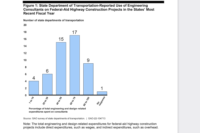As the partial federal shutdown moved into its fourth week, Oklahoma and New Mexico’s departments of transportation have delayed lettings for some of the highway projects for which they had planned to let bids this winter. They cite uncertainty over federal funding as a reason for the decision. But there doesn't appear to be a wave of such bid delays across the country.
Oklahoma DOT, noting questions about federal funds, says it is delaying about 45 highway and bridge projects totaling an estimated $137 million that it had planned to include in its January and February bid lettings. It still plans to proceed with bids on $150 million in projects over the two months.
New Mexico DOT has delayed its scheduled January bid letting. A spokesperson said via email on Jan. 8 that factors behind the decision include the recent swearing-in of a new governor and other administration officials, “which delayed high-level decisions regarding funding options” at that point. She also noted that a 2018 stopgap appropriations measure initially only provided federal highway obligations through Dec. 7.
Though the U.S. Dept. of Transportation is one of the departments and agencies caught up in the partial shutdown, its federal-aid highway program continues to operate because it draws on the Highway Trust Fund.
The shutdown began on Dec. 22 after the second of two short-term stopgap continuing resolutions (CRs) lapsed.
The problem is that—as New Mexico DOT indicated—the Federal Highway Administration initially had allotted to states only about $8.2 billion, or 68 days’ worth, of the $44.2-billion, full-year highway obligation limit set under the initial CR, which ran from Oct. 1 to Dec. 7.
A follow-on CR kept federal agencies open until Dec. 22 but didn’t immediately affect the obligations.
Then FHWA on Jan. 8 issued a revised plan, and made available to states their complete shares of the full $45.3-billion 2019 obligation limit set in the current surface-transportation authorization law, the Fixing America’s Surface Transportation Act.
But there is a potential catch. FHWA also told state DOTs that if Congress passes another part-year CR, that stopgap measure probably would “significantly reduce the amount of obligation limitation available to each state.” The agency warned, “States should plan accordingly….”
Joung Lee, American Association of State Highway and Transportation Officials director of policy, says, “The practical impact is that [state DOTs] really can’t program and commit those dollars beyond, like, today. That’s what you’re certain of, up to that point.”
Lee adds, “Anything beyond that has the risk of being de-obligated or having to be returned to the Federal Highway Administration.”
Terri Angier, an Oklahoma DOT spokeswoman, told ENR in a Jan. 10 interview that working under the latest FHWA allocation is “a very risky thing.”
The winter lettings are important, Angier says. “Our January and February bid lettings are very large," she says, "to catch the spring-summer season for projects and for environmental issues.”
The January letting “is gone,” she says. “Now, If Congress comes back in tomorrow and things are back in order, February could be saved. We don’t want to cry wolf here.”
Angier adds, “We’re getting close to February being a solid slide, instead of a tentative slide. But right now, it still could get saved.”
As for New Mexico DOT, the spokeswoman said that the department “is currently reviewing options in order to move projects forward to avoid any delay in awarding new construction jobs pending the approval of [an] appropriations bill or a continuing resolution.”
The NMDOT spokesperson also noted FHWA’s memo, and said it provided “a short-term cash-flow solution” for state DOTs, pending a new CR or full appropriations measure. She added, “This only means that states are being provided a pro-rated amount based on estimates and states should be prudent in moving projects forward.”
Utah DOT, however, isn't altering its bidding plans so far. “Our team will continue to watch the situation closely, but at this point we are continuing to advertise all of our projects,” spokesman John Gleason said Jan. 17 via email.
Gleason added, “It’s a fluid situation, and our approach may change depending on how long this goes, but as of now we will continue as planned.”
He also noted that federal funds account for only about 20% of the UDOT budget. “So we are in a better situation than some states,” he said.
Brian Deery, senior director of the Associated General Contractors of America’s highway and transportation division, said in a Jan. 16 interview that in general the effect of the shutdown on highway contracts and construction has been small.
Deery adds, “Depending on how quickly they get this resolved, it will probably have a minimal impact, because of the way the highway program is funded. There is money in the trust fund.”
At the Portland Cement Association, which has a major focus on infrastructure work, President and Chief Executive Officer Michael Ireland says that, anecdotally, he hasn’t heard much yet about the shutdown from member companies.
Ireland said in a Jan. 17 interview, “I think this is somewhat new for everybody–we haven’t had a shutdown that’s lasted this long. And we’re not really sure what end is in sight.”
He adds, “So I think they are going to get a little more apprehensive about this.”





Post a comment to this article
Report Abusive Comment